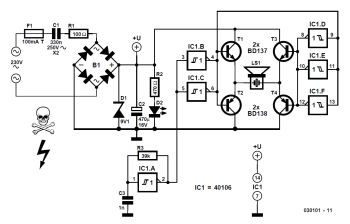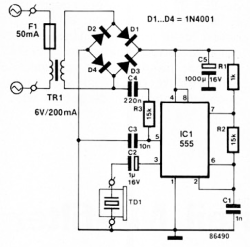Review: Ultrasonic Rodent Repellers – Operation and DIY Construction
DIY Construction
After examining these commercial devices I took a dive into the Elektor archives, because we have already published circuits like these in the past. I found a few designs and while they are tens of years old they are still very good for DIY construction.

for repelling mice and rats.
The first circuit dates from 2003 and although the title “Dog and cat repeller” would suggest otherwise, this design is also suitable as a mouse and rat repeller. An oscillator is built from R3, C3 and IC1a and the component values have to be such that it generates a frequency of 38 to 40 kHz (C3 = 470 p, R3 = 56 to 68 k). The square wave is presented to an H-bridge that is built from a few Schmitt-triggers and four power transistors (T1 through T4). This design ensures that the peak-to-peak value of the square wave is twice the power supply voltage. In this way a considerable voltage, amounting to about 18 V peak-to-peak, is developed across the piezo element, which results in quite a loud squeal. The circuit is powered directly from 230 V via C1 and R1 and is therefore not electrically isolated from the mains. This means that the circuit has to be built into an insulated enclosure. Only commonly available components have been used, the biggest challenge will probably be finding a suitable piezo element.

output signal is also swept.
A much older circuit is the “rodent repeller” from 1986. The principle of this circuit resembles the second commercial design somewhat. A 555 timer IC functions here as the oscillator. This IC has a frequency modulation input at pin 5, to which a 50-Hz signal derived from the mains is connected. As a result the output frequency is swept quickly between about 20 and 40 kHz, so that the mice do not get used to it. The piezo element is here directly connected to the output of the 555. The power supply is a classic design using a small transformer, but a mains adapter that you may have on hand will work equally well. In the latter case, the construction into an enclosure is not that critical from a safety point of view. Here too it is very important to use a good quality piezo element (if need be, salvage one from an old piezo tweeter).
And did any of this help at all? I got rid of the mice, by I'm not sure whether that was because of the ultrasonic beepers or from all the other measures I took, such as plugging all the gaps and holes. In any case, there is no harm in trying!



Discussion (0 comments)